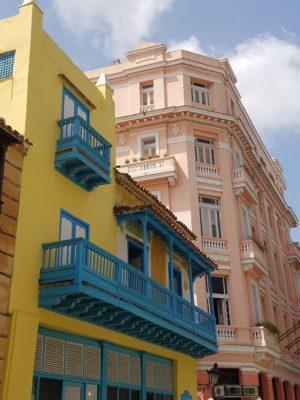
Colorful European Buildings Line Havana’s Streets
Apr. 5-7: When people think of Cuba, they are usually thinking about Havana. Makes sense, when we think of New York State, most of us think of New York City. Think 1950’s Chevrolets, cigars, rum, dilapidated but formerly stately buildings, the malecón, and some of the most soulful, percussion dominant music on earth. That blend of elements surely imprints intriguing images of Cuba in our minds.
Within hours of arriving in Havana, I agreed. It was a gritty, edgy, intriguing city, full of contradiction, throbbing with a heartbeat unique as fingerprints are to each person. In a broad way, I knew I was immersed in a Central American or Caribbean culture. But there are cultural differences that distinguish Cuba.
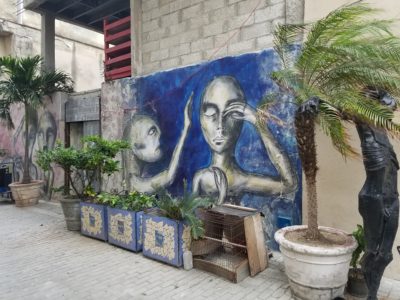
Murals Every Which Way Are Very Cuban
At the Airport
Let’s start at the airport. The female employees all sported some very provocative black fishnets. It was enough to make men raise their eyebrows and gaze downward. With nothing to declare, customs was a non-event for me. Although the line stretched out with Cubans who were declaring large electronics and appliances. A bilingual Argentinian woman informed me that it is actually cheaper for a Cuban to fly to America and buy to a TV, than to buy it in Cuba. I am not sure I fully understand it, but obviously there are sky high tariffs on certain items bought in Cuba.
Now maybe we Americans have just been brainwashed, but I was truly expecting Cuba to be very chaotic and disorganized. I was thinking Mexico or Costa Rica multiplied by a factor of five. Yet, I quickly discovered there is order here, at least in certain things.
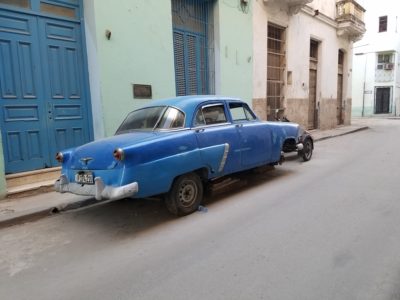
Cuban Streets Are Old Yet Clean
When I went inside the bank, there was a man who told me where to sit and then when to stand and finally what papers to take out. He did this with everyone who walked in the bank. He carefully moved the line along with precision. Speaking about precision – let’s talk about the tellers who count the money. They counted it five different times before giving it to me. Some of this involved having them count it in front of another employee. I realize they want to get it right, but they go above and beyond with their processes to ensure that. So they have a way they do things, it’s not the most efficient way, but it works. It keeps unemployment rates low and they are sticking with it.
Driving in Cuba
And the manner in which people drive was another surprise. In most places in the developing world people drive like a bat out of hell. The cars rule and you better watch out if you value your life. Different countries fall into a spectrum of crazy to orderly, but you get the point. Cubans drive very slowly and are extremely polite on the road. Part of the slow driving is due to the 1950’s cars, they simply don’t have fast as an option. Yet there are more modern European cars that have the capacity to make some distance and they keep pace with the dinosaurs. And they also stop for pedestrians – I almost thought I was in Portland, Oregon!
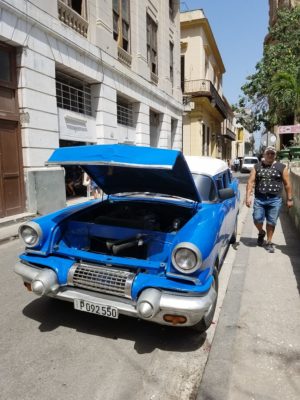
Driver’s Cannot Speed, Even If They Wanted To!
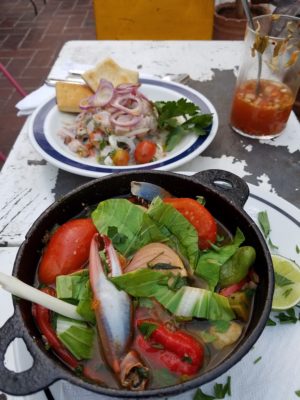
I Was Not Expecting Cuban Food to Be So Abundant and Fresh
First Evening and Cuban Food
I selected a restaurant for dinner and, when I tried to enter, they told me they were all full, but pointed across the street at a different restaurant and said it was an extension of the one I had chosen. I am not actually sure that was the case. It was more likely that they were friends and pat each other’s proverbial backs when given the chance. This was the type of confusing experience I was expecting from Cuba. You are never quite sure exactly what is going on. And they want to keep it that way. But the food was spicy, flavorful, and full of fresh veggies and I liked the rooftop dining. So it mattered not.
My first evening was all about getting a lay of the land and slowly absorbing the culture, as if Havana was a shot of rum, to be sipped and savored. I oriented myself in the old town, which was full of plazas. Four large ones and some smaller ones as well. The streets were teeming with people. Since it was the shoulder season, I was not expecting the crowds. On the other hand, I like seeing so many people enjoying such an engaging place. Families, couples, the young, the old, the Cubans and the tourists – all come out at night.
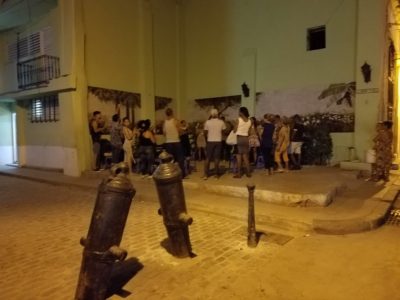
Warm Nights + Music Lovers = Havana Vibe
The weather had cooled off just slightly and the music brought everything to life. The emphasis was on percussion, but not limited to it. Most of it was live, but some was recorded. It didn’t really matter though. Somehow it was all tied together in what defines Havana. And the pulse radiated out from a thousand epicenters, drawing anyone and everyone into its sphere, uplifting the spirit.
My Casa Particular and Cuban Entrepreneurs
In 1997, Raul Castro allowed Cubans to rent out rooms in their home as an extra source of income. They are called casa particulars. It is similar to Airbnb, which now is also available in Cuba. You need to book through a third party, analogous to booking through Airbnb, but you communicate only with the third party and not your host. And you are definitely renting a room in the host’s home, as opposed to having the option of an entire home. There are some standards, like the doors lock and the host will generally offer you breakfast or other meals for a fee. The casa’s name is the owners’ names, like Pedro and Olalie. I don’t quite know the evolution over the last 20 years, but suffice it to say that Cubans are eager to have another stream of income in their lives. The government provides a lot of basic services for its citizens, but an entrepreneurial spirit cannot be squashed, no matter how hard a government tries.
I selected my Havana casa particular in Viejo Habana, as I wanted to be close to the action. The apartment was the top story and the balcony that overlooked the malecón was sumptuous. Pedro and Olalie were polite, but not overly friendly. They and their family gathered in the TV room toward the back of the home, which left the entire tiled living room and balcony to me.
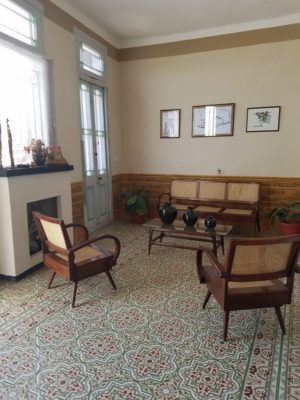
The Common Space in the Casa Particular
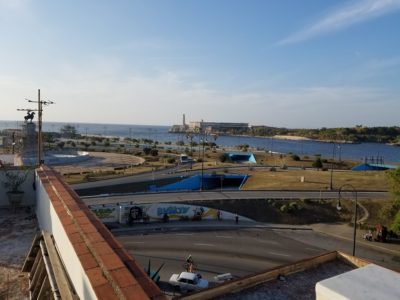
Who Could Not Love the View
My room was simple and suited me just fine. I loved that the table was an old Singer sewing machine. The vanity that held the sink in the bathroom where I ate dinner was made of a Singer sewing machine as well. I expected the Cubans to be resourceful in this way and they were not letting me down. Amazing what people can make do with, when they have no other choice.
In the morning Olalie offered me café Cubano (Cuban coffee) which meant a strong shot of espresso with sugar. Not being a usual coffee drinker, I said yes, but asked for no sugar. Muy fuerte! This sort of surprised her, but she made it as I requested.
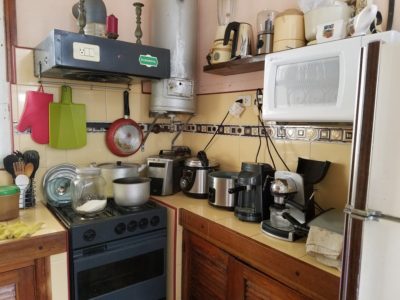
Casa Particulars Are Better Equipped Than the Common Cuban Home (Two Coffee Makers!)
Bearing Gifts of Spices
This was the moment to show Olalie the spices I brought from the states. Cubans are unable to import or obtain many things. Having heard that Cubans cannot import spices and being a lover of food and plants, I was honored to be sharing spices. Let someone else bring Skittles and mini bottles of shampoo. Neither Pedro nor Olalie spoke a word of English, but we managed to communicate well enough. The language of plants often needs no words. Olalie’s face lit up as she sniffed the cumin and coriander. She recognized the word oregano, since the Spanish word is the same.
It is meaningful ritual when traveling, to find some way to give back to the place you are visiting. One of my ways in Cuba was sharing the spices. Other ways could be volunteering for a cause, donating money for a social issue, or working and helping citizens along the way. Travel in general becomes more meaningful when there is a sense of purpose attached to it. For me, I know that I crave the feeling of contributing in some way to the community.
Back to the Streets of Havana
The hordes of tourists were out. From what I could tell, most of them were from Latin America, although there were plenty of Europeans as well. Comparably, just a smidgen of Americans. Although the US embargo has been in place for over 50 years, other countries have continued or reestablished relations with Cuba. And although I can only observe from the periphery, the Cubans don’t seem to be suffering. Elements of American culture seep in, the local restaurants seem to have a propensity for 1980’s American pop culture, think Olivia Newton John, Lionel Richie, and Rocky V. And the parts of American culture that have not seeped in, like 7-11 and Coca Cola, well they have their own versions, although not in such abundance.
The mimes and musicians were some of the best I have ever seen, even including the talented ones in Lisbon. Their outfits were elaborate and they were definitely on top of their game – pay to see them play. Some of the bands had women whose job it was to pass around the hat and sell CD’s. Even the traditionally dressed Cuban women were working. Their garb was elaborate and the cigars were BIG. Their shtick is to “look Cuban” with a friend or two and charge money, if you want your picture taken with them. Everyone else, Cuban or otherwise, wore more casual clothing.
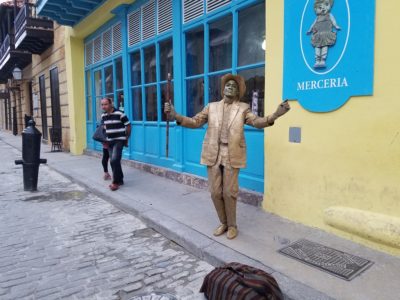
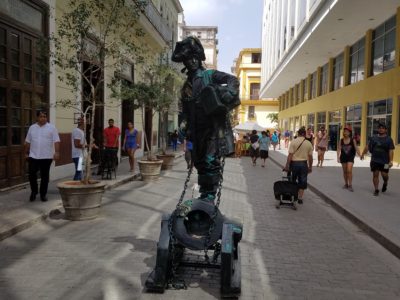
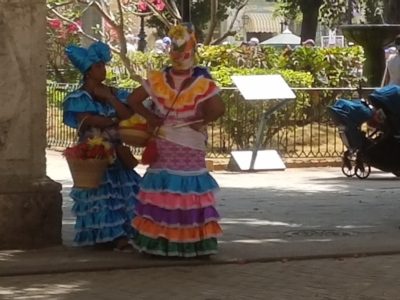
They Dress “Cuban” For Show
If you want a taxi in Havana, have no fear. You could literally throw a rock in any direction and hit ten of them. I think I lost count at 500 offers of a taxi ride, no joke! And as far as taxis go, you have your choice. The 1950’s cars are the classic experience for the tourist. Too old – what about a small, modern European car painted yellow and black to mirror a NY cab? Not eco enough – what about a smart car painted yellow and black? Still not eco enough for you – bicycle taxis abound! Standing at one plaza, I saw hordes all lined up, eagerly waiting to take you where you want to go.
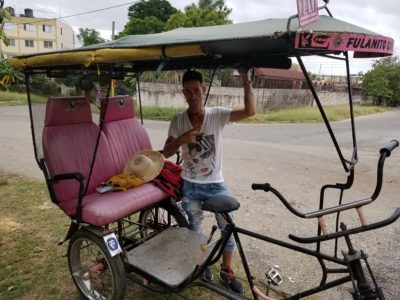
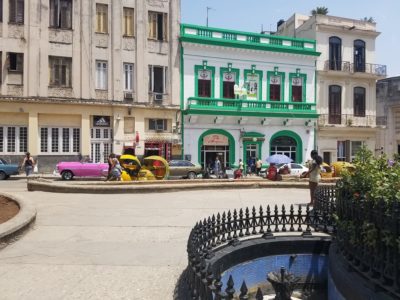
Taxis Come in Different Shapes, Sizes, and Colors
There is a plethora of pro-revolution propaganda scattered through the city. I say this as only an observation and not a judgment. Fidel Castro and Che Guevera’s faces are featured everywhere from billboards to murals to stickers to sides of very tall buildings. Saturating the city the way they do, my opinion is that it would be hard for the Cubans to consider objectively their feelings about the government. On the upside, this and the fact that they are a small landmass, they probably have more political harmony than in a large and diverse place like the United States.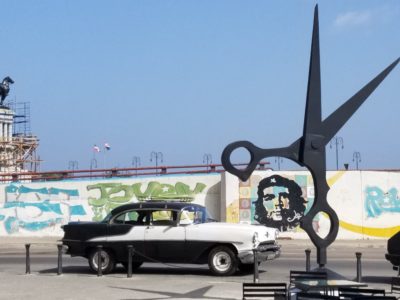
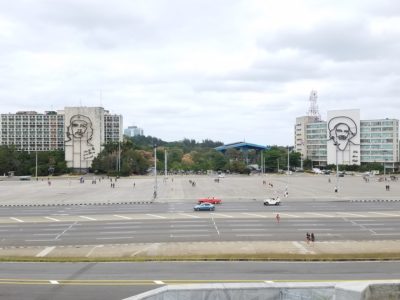
Che Guevera and Fidel Castro Reign
Exploring Old Havana
I spent the first full day exploring Viejo Habana (old Havana), popping in and out of local galleries, food markets, and shops, as well as allowing myself time for some diversions to watch and interact with locals.
One thing that defines Havana that may surprise us is the amount of art woven into the culture. We generally think of art being for people who have extra time and money on their hands to create and appreciate it. Cubans don’t have extra money, but something in the culture, maybe years of communism morphed into socialism, allows them to not worry so much about survival so they can redirect their energy elsewhere. So they can redirect their energy elsewhere. Like painting, acting, and sculpting. Just my theory.
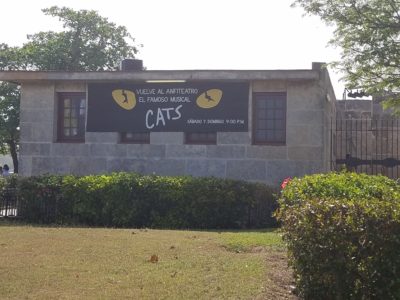
Broadway Plays
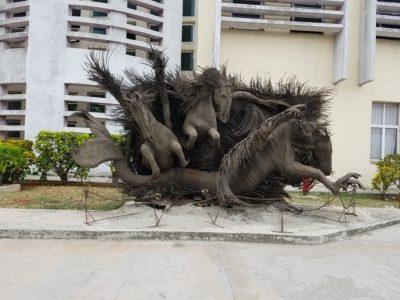
Dragon Sculptures
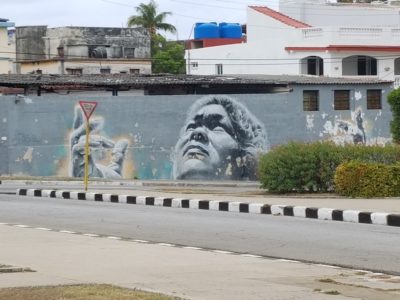
And Murals
Art galleries abound. Some are staffed by the artists themselves – sort of like self-publishing. Others seem to be more of a multi-media collective. Some of the art was edgy and provocative. Erotic nudes, but not explicit. A poster of Obama that looks like his campaign poster saying “Yes, I Came” instead of “Yes, We Can” tipped me off that the Cubans would be happy to have the embargo lifted. Pictures of Lennon and Guevera, although Lennon never went to Cuba, spoke to me that Cubans romanticize that socialism is utopia. Another gallery I walked into was full of all sorts of weird art made from junk – hockey tables now adorned with old copper wire. Ballet slippers stuffed and hanging from a large painters’ palette. Definitely some weird stuff in there!
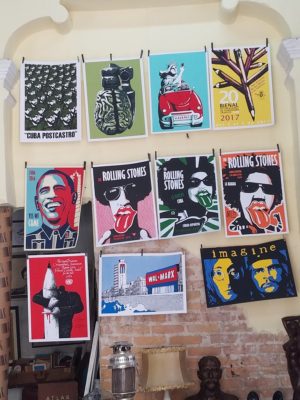
And An Artists’ Collective
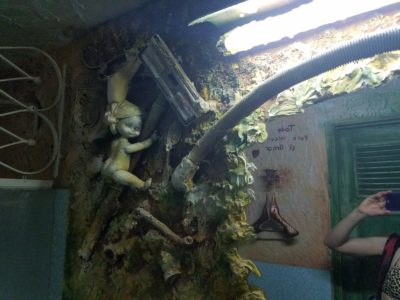
Weird Garbage Art
Havana is full of old crumbling buildings and while they are a long way off from gentrification, lots of artists just set up shop inside, as if they were not in a state of disrepair. Picture gray plaster, brought to life with the bright colors characteristic of Cuba. These are the contradictions one could expect to scratch their head over.
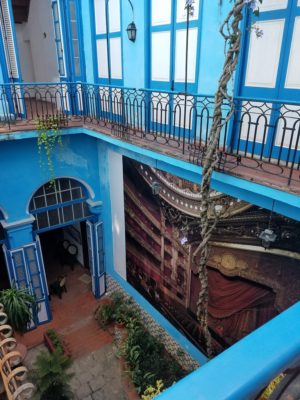
Victor Hugo Brings Paris to Havana
I didn’t realize Victor Hugo had a home in Havana (actually he did not, but this was built in his honor). It was in a building with French architecture and on the inside of the courtyard, a huge mural that was most likely the Opera House in Paris. Upstairs, there was a room with AC that was showing a film in English (with Spanish subtitles) about Rudolph Steiner. Cuba really is a melting pot of cultures and influences and ideas.
The streets were also filled with art, sometimes in unlikely places. Murals of Jimi Hendrix and Jim Morrison. Banners advertising the Broadway play Cats. Gates decorated with what would be considered garbage in America.
Resourceful Cubans
And next to all of this, are people fixing their old cars and bicycles. Since they have not been able to import parts, they have invented ways to keep things running. I saw two men disassembling a wire bed spring frame and somehow fashioning the wire to fix a bike taxi. Seeing men underneath the old cars with popped hoods was commonplace. I wish I had a dollar every time I saw this. With gas rivaling European prices, I cringed at thinking how much money it costs to keep these gas guzzlers running.
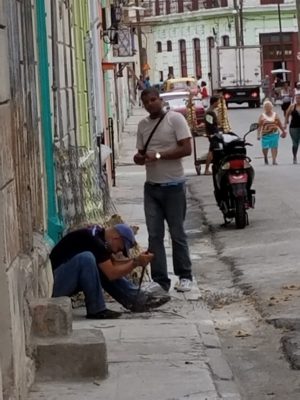
The Old Box Spring Will Be Transformed into a Bicycle Part!
Just like everyone in Oregon is a foodie, everyone is Cuba is a mechanic. It would be easy to say that it’s in their blood, but I am sure they have all learned out of necessity.
Speaking of being resourceful, tucked behind a corner of a museum, I noticed a man sifting sand and debris through a homemade sifter and I asked to help. From what I could gather, the mix was from falling apart buildings. It was laborious since the sifter could only handle a couple of shovelfuls at once. Yet, over time, it was separated into sand for rebuilding and a pile of debris. It’s important when traveling to take time out for such things. The people performing manual labor are much closer to your average citizen than those who are working in upscale hotels. It’s great to talk to hotel staff as well, but in the course of a trip, rounding out the interactions will provide a greater understanding of what the daily grind is like in your destination.
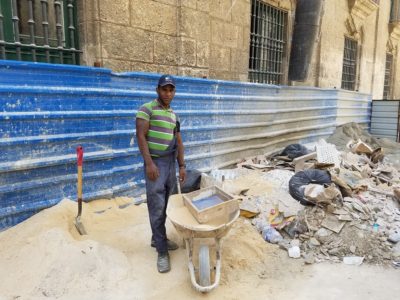
The Life Cycle of Buildings
An Evening Walk to the Beat of Cuban Music
My evening walk brought me to the plazas that featured salsa music, Beatles music, and African influenced music. It is refreshing that the Cubans are not afraid to dance. People just let music move through their veins in such a natural way here. It reminded me of the young people dancing in the streets of Lisbon. I wandered to the water and used my sense of direction to try to get home, since google maps doesn’t work there.
Well, I was off by one block and when I followed the music, thinking I would get back to the plaza, I landed in front of 20 people gathering and singing on a street corner. There appeared to be a leader who would talk to them and then play something on the boom box and everyone would join in. It almost sounded like a choir. Young children, probably belonging to the singers played nearby. This is one example why I think Havana is a safe city.
The main annoyance in the city is being “befriended” by locals, who try to take you to their friends store to buy something and get a commission. It happened my first night, when I bought a drink for someone. It happened the next afternoon when a woman told me her friend gave salsa lessons, but I needed to buy a drink to find out she didn’t offer lessons. And it happened my second evening, when I thought I was going to hear some music with a local, but it was sort of far away and required admissions and drinks. Although this third “befriending” was the charm and I ended up walking away and catching a ride home. Anyway, if this is the worst of Havana, it is not a bad thing. But do be aware should you go there, so you don’t get too sidetracked too much of the time.
Around and About in Havana
I started my last day in Havana by catching a bike taxi across the city to the Cemetery of Columbus, which took 40 minutes. The driver stopped at friends’ houses or when he saw friends on the road, which was sort of fun. I tried to ride the bike, which was very shaky, and scared him, so he took over. At points, we were pushing it up a hill! The cemetery was expansive and did not feel eerie. Some areas were sparse and reflective, other areas had tour buses galore.
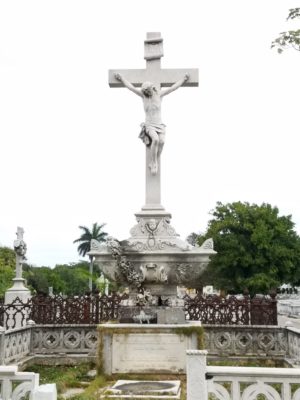
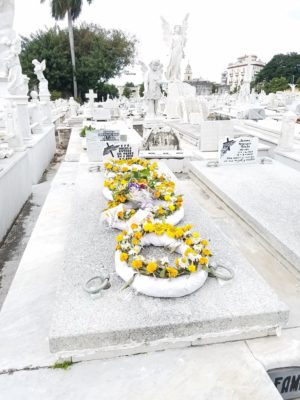
The White Stone Actually Gave a Bright Feeling to the Cemetery
I spent the rest of the day walking back toward downtown, stopping at major sights along the way. The regal statue of José Martí was a showstopper, although with long lines, I skipped going up in the elevator. I got to explore the Vedado hood, which is where the average Cubans live, work, and eat.
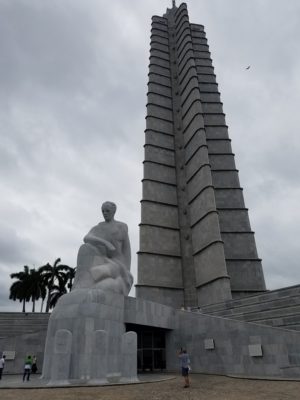
José Martí is Cuba’s Most Famous Poet
I saw modest sized parks with school children in mustard yellow uniforms. Three boys teasing a girl and throwing things her way, grade school flirting.
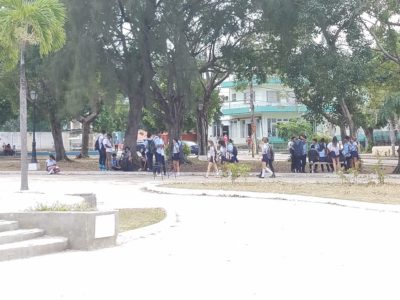
Vedado Neighborhood Is a Slice of Everyday Cuban Life
Along my walk there were a variety of homes in different styles and conditions. Part of what is intriguing about Cuba is the juxtaposition of things. The old and the new being the obvious one. The building styles being another. The colors that don’t match, but in some way, they all do, as part of a bigger puzzle. Quotes from Bob Marley next to quotes from Picasso on the wall of the Iranian restaurant. You catch my drift.
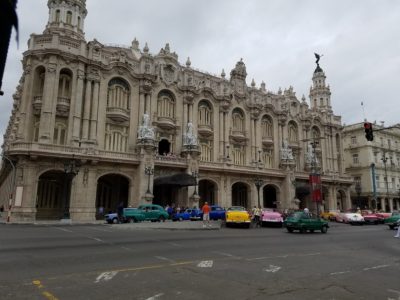
This Building Was Half a Block From. . .
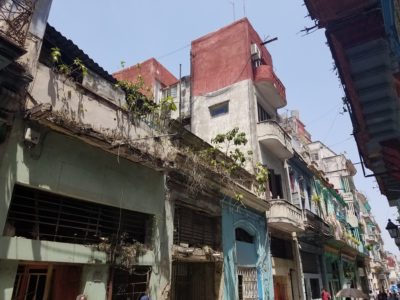
. . . This Building
Museums, Synagogues, and Convents — Havana Has Them All
The National Museum of Decorative Art was built by the French was a tiny slice (very, very tiny) of the Louvre. Although it contained German porcelain, Italian glass and Chinese china, amongst the mostly French art. The Napoleon museum on the university campus is worth a stop, especially to climb to the top for the view and to see the swords that belonged to his family members.
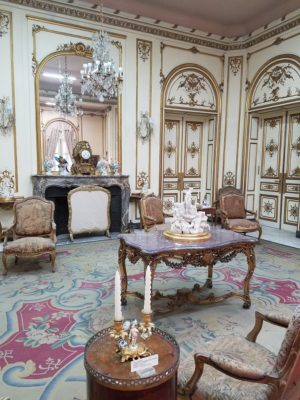
The French Left Their Stamp in Havana
Getting to the synagogue was a lesson in humor and patience. I went to where the map showed it was. Instead, there was a French immersion school. Between the nice gentleman speaking his broken English and my broken Spanish and French, I was directed to the right place! I did get a tour of the synagogue, which is one of the five in Cuba, three of which are in Havana. They have no official Rabbi, but one travels a few times a year from Chile to help. Certain members of the community study together and lead services. It’s very grassroots, which I found charming.
On the wall, were separate pics of visits from Spielberg, Fidel (who was interested when he heard Chanukah was like the Cuban Revolution), and Raul. Asked if people gave Jews problems in Cuba, my guide said no, because people are so full of their own problems, that they don’t have time to bother others.
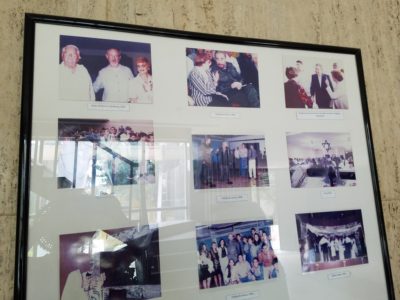
Look At the Top Three Pics – Spielberg & the Castro Brothers
The Convent of Carmen could very well be the prettiest church in the city. And uncrowded, so it’s even better! Intricate tile work on the walls, painted ceilings with biblical scenes. It was definitely a prime place to be surrounded by beauty and tranquility. If I did not know otherwise, I could have been at the Queluz Palace in Lisbon.
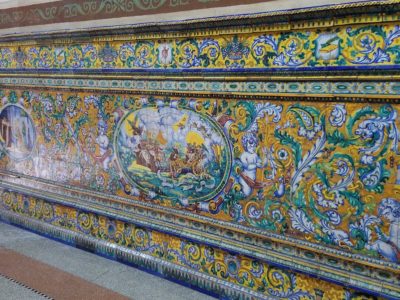
Tiled Murals at the Convent of Carmen
Going into a couple of local markets, I was amazed at what I could buy with the local currency as the price. I was getting about ten times of what I expected with the tourist (convertible) currency. Besides that, I think people also charge what they feel like, which could change by their mood, the weather, and the moment.
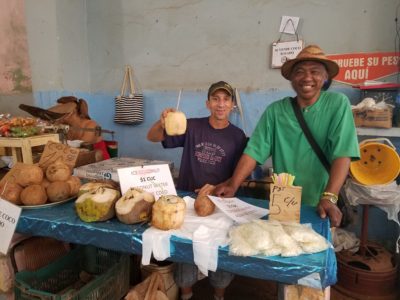
Nothing Pretentious About This Local Mercado
I stopped for a cold drink and salad at the restaurant right outside my casa. That ended up being the bulk of my evening, because I joined a table of four Americans and we got to talking. Two sets of dads and sons. We exchanged travel stories and they explained they spent two hours finding coffee that morning. They went to one store, told it was at another, and another. On the coffee hunt, they also discovered it was toilet paper day. People had carts full, because if they didn’t get what they needed, they would need to wait another month for toilet paper day.
Since one of the son’s was fluent in Spanish, he was able to converse with the waiter about all manner of topics. In short, we realized that a restaurant owner is paying close to 20% of their gross income in taxes (not net, gross). The waiter had a government job as a psychologist, but moonlighted for extra income. When the son asked if the waiter was happy with the system, he responded by saying he was happy and felt like it worked, but when tourists came and informed him how bad it was and how much better it was elsewhere, then he questioned his own happiness. It’s interesting to ponder that what the Cubans, or any other group of people, base their opinions on is always such a limited view of the big picture. This certainly can keep things simple and orderly, which has its own upside.
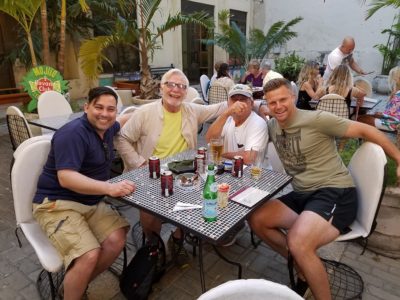
I Gravitated Toward a Group I Could Speak English With
So What Exactly Is That Bus Schedule?
Utilizing my new, fluent Spanish friend I tried to get the skinny on where the bus station was as I was going to Soroa the next day. I had tried to find the station in the afternoon, but it was not where it was on the map. I asked someone, and he pointed in a different direction, so who knows. The waiter gave yet another response and solution and said I could buy tickets at a hotel, as they all sell them. I later went home and asked my hosts and they pointed on a map to a bus station near the cemetery. Had I known that at the beginning of the day, I would have walked there after the cemetery.
When I went back out for the evening to continue the bus station search, I got a few more stories of locations and options of who could sell me a ticket, but not until 10 AM. Then I was sent to another hotel that supposedly could do it, but they had never heard of such a thing.
I did ask at yet another hotel where a woman spoke English and she directed me to the same place Pedro did, but said I should have gotten a ticket two days ago, as it could be sold out. She made sure to let me know I should get there no later than 6 AM, to hopefully win the lottery.
I was feeling a bit nervous, but was sure I would somehow get what I needed. I always do. And anyway, I was in Cuba, where everything is muy complicado!
Click here to see what I did next in Soroa.
And what else I was up to in Viñales and Palma Rubia.
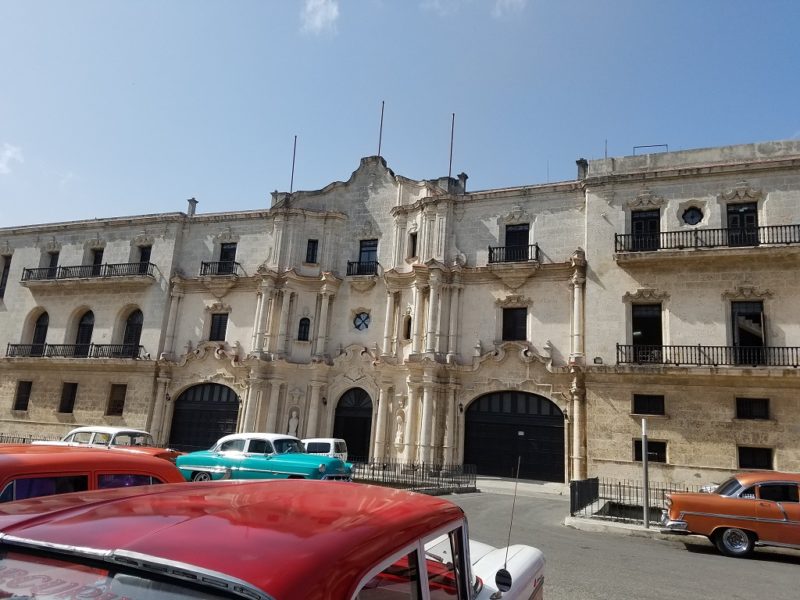
Cuba Is Made of Layers of History and Cultural Influences
